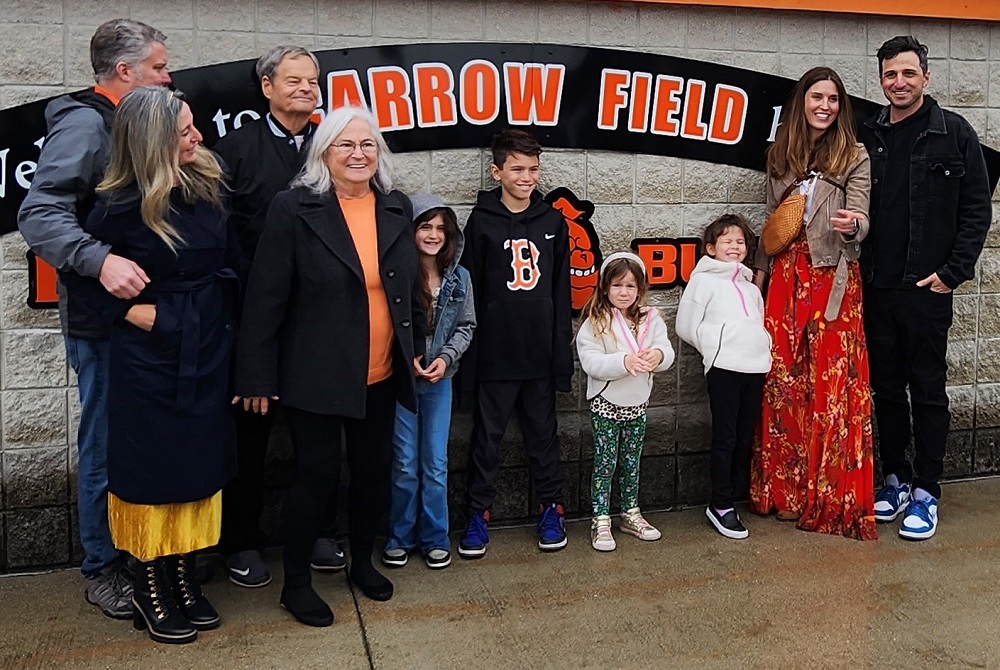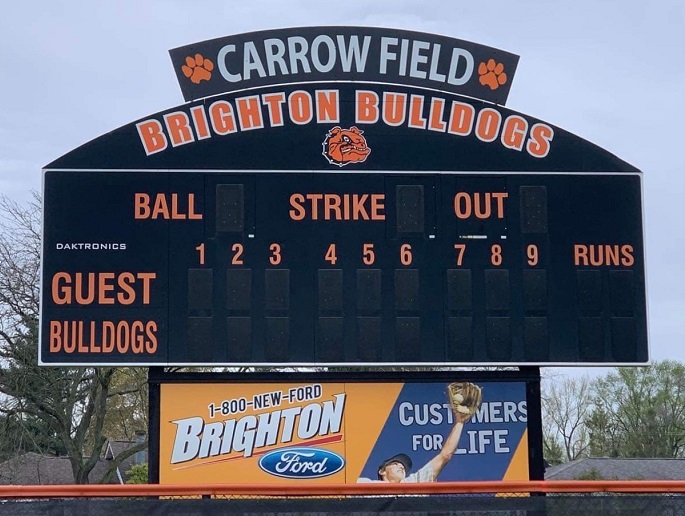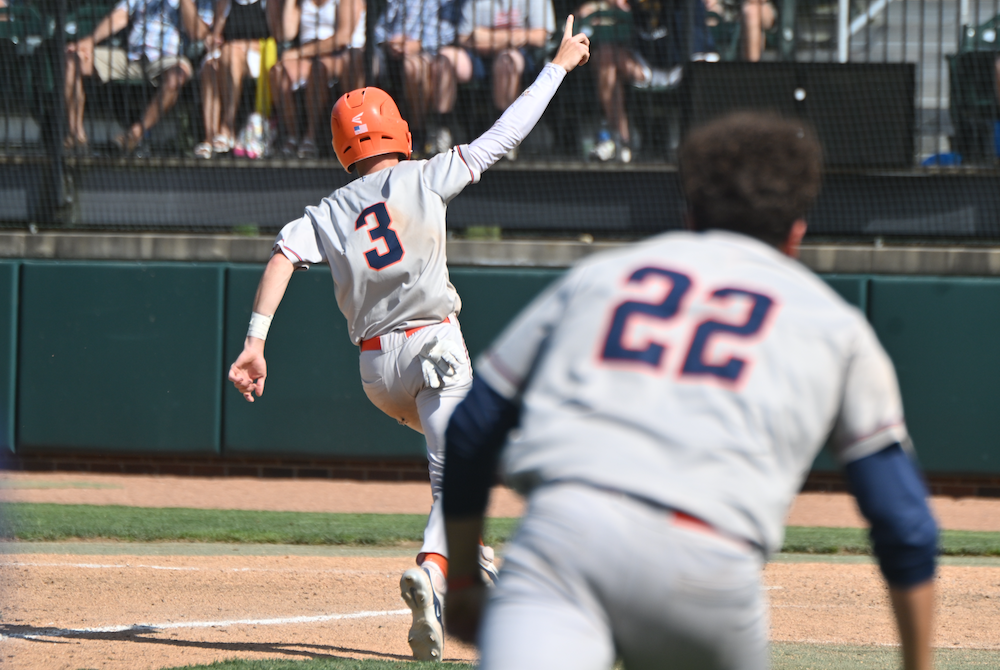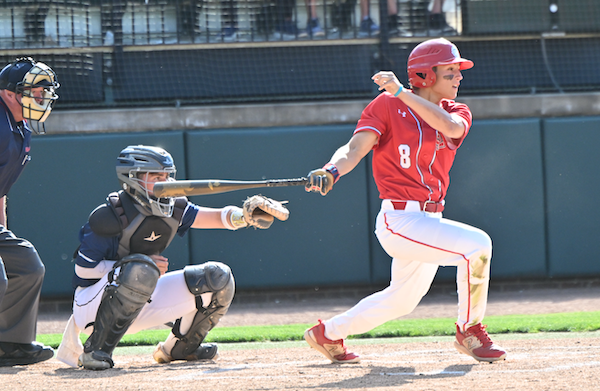
Brighton Names Baseball Field for Program Builder, Longtime Leader
By
Tim Robinson
Special for MHSAA.com
May 4, 2023
BRIGHTON — Mark Carrow didn’t know what to expect April 22 when he arrived at Brighton High School’s baseball field, where he was the guest of honor for a ceremony officially naming it Carrow Field.
 “I remember back in October, when they announced this would happen, I told my wife, Mary, that there will be probably 60-70 people here, because there are 18 players on each team and their parents,” he recalled. “We pulled up here and there were all these people, and these young men who look older now.”
“I remember back in October, when they announced this would happen, I told my wife, Mary, that there will be probably 60-70 people here, because there are 18 players on each team and their parents,” he recalled. “We pulled up here and there were all these people, and these young men who look older now.”
Dozens of Brighton alumni, some of whom Carrow hadn’t seen since their high school days nearly a half-century ago, were in attendance for the ceremony held before a doubleheader with Ypsilanti Lincoln.
Carrow retired in 2006 after 34 seasons as Brighton’s baseball coach, recording 823 wins, now eighth on the state’s all-time list. He also was an assistant football coach and coached both boys and girls middle school basketball.
He came to Brighton a year after graduating from the University of Michigan, where he played baseball for the Wolverines, starring at third base.
“My dream was to coach baseball at Ann Arbor High,” Carrow said of his high school alma mater, now Ann Arbor Pioneer. “That was my dream.”
But he had applied to Brighton Area Schools as well, and after a year teaching in Grand Rapids, he and Mary both were offered teaching positions.
“Wouldn’t you know it? We were in school for two days and Ann Arbor calls me up,” Carrow said. “They had a phys ed job open. I’d have been the JV football coach, and I knew the baseball coach was on his way out. It was everything I wanted, and I went to (administrator) Bob Scranton and said, ‘Here’s what’s happening.’ He told me to think about it over the weekend and come back Monday.
“My wife and I talked it over, and we were so grateful to Brighton for giving us a chance to be near our hometown that we felt we owed them a year,” Carrow said. “In November, we bought a house that we lived in for 22 years.”
Brighton’s sports teams weren’t the dominant squads of today. The football team had had two winning seasons in 20 years, and the year Carrow arrived went 0-9.
“We played in six homecoming games, including our own,” he said. “Everyone wanted to play us.”
The baseball team wasn’t much better, having gone decades without a winning season.
But the Bulldogs were 12-12 that first spring under Carrow’s leadership, and never finished below .500 during the rest of his tenure.
 The Bulldogs joined the Southeastern Conference the next year and got off to a 7-0 start before losing at Lincoln.
The Bulldogs joined the Southeastern Conference the next year and got off to a 7-0 start before losing at Lincoln.
“The kids were crying on the bus ride home,” Carrow said, “and I knew right then that Brighton had turned a corner, that it meant something to win and losing wasn’t acceptable anymore.”
Brighton took off, winning 20 games or more in all of his last 23 years as a coach, and a total of 13 league titles, 12 District titles, three Regional crowns and while making two trips to the Semifinals.
The talent was there, too, including 16 all-state players and two Mr. Baseball Award winners in Ron Hollis and Drew Henson.
Carrow earned national and Michigan Coach of the Year honors three times apiece and was inducted into the Michigan High School Baseball Coaches Hall of Fame in 1992.
The field was renamed in his honor after the Brighton school board changed its policy to allow the renaming of facilities to honor living persons less than two years ago.
But Carrow is quick to cite the reasons for his success.
“The players are the ones who made this possible,” he said. “I mean that from the bottom of my heart. I never threw a pitch or hit the baseball. I got 800 wins, but it was because of them.
Carrow has a photographic memory, which came in handy while chatting with former players.
“It was funny, because with each kid I remembered an incident about them,” he said. “Jeff Bogos, who I hadn’t seen since he graduated in 1979, came out and I said, ‘Do you remember when we were at Milan and your knee went out (of place) in the middle of the field?’ It happened twice. He said, ‘How do you remember that?’ And I said, ‘How could I not?’”
Carrow moved to Florida after his retirement, where he and his longtime assistant, George Reck, meet up a couple of times a week. He makes frequent trips north to watch U-M football and to visit his son, Chris, who lives in Chicago.
Baseball is firmly in his past.
“I think I’ve been to one high school game since I went down there,” Carrow said. “I hated the way the coach was coaching, and Mary did, too. She said, ‘We don’t have to watch any more high school baseball,’ and I said, ‘You’re right.’”
When he retired, Carrow said he would likely be forgotten in a few years.
Seventeen years later, his legacy is assured and his memory will be invoked any time one looks at the scoreboard in left-center field that has a “Carrow Field” sign on top of it.
Not bad for a coach who was in the right place at the right time.
“My dream was fulfilled, and rightly so,” Carrow said. “And, believe me, I made the right decision. I couldn't have had better kids to teach or lived in a better community. It couldn't have worked out any better.”
PHOTOS (Top) The Carrow family stands together in front of the welcome sign to Carrow Field – including daughter Tiffany (front left), Mark and Mary (second from left, front and back) and son Chris (far right). (Middle) The Carrow name stands tall atop the scoreboard at the field named for the longtime coach. (Family photo by Daniel Collins.)

Flint Powers Catholic, Spring Lake End Long Waits to Reach Season Finale
By
Scott DeCamp
Special for MHSAA.com
June 14, 2024
EAST LANSING – After his eighth-inning, game-winning hit to finish Flint Powers Catholic’s Division 2 Semifinal win Friday, Chargers senior Gavin Darling gave away the secret to how 42-year head coach Tom Dutkowski stays so young and energetic.
“That dude works out more than probably half the team, honestly,” Darling said. “He’s a great guy, and we just want to do it for him as well.”
What top-ranked Flint Powers is aiming to do is capture a state baseball championship. Powers has that chance after Darling’s walk-off single to deep left field scored Eli Sturgess for a 4-3 victory over Trenton at Michigan State University’s McLane Stadium.
Powers (36-6) will face Spring Lake (32-9) in Saturday’s 5 p.m. Final. The Chargers are seeking their first Finals title since 1980, and first under Dutkowski’s tutelage.
“We want to win for him, man. It’s not only for us, but it’s for him,” Darling said. “He’s been working hard just like we have.”
Powers and pitcher Grant Garman cruised through the first four innings Friday, Garman carrying a perfect game as the Chargers built a 3-0 lead.
Trenton (30-11-1) began to make Powers work for it in the fifth. The Trojans collected five hits and scored three runs in the inning, keyed by Carson Boike’s two-run single, to knot the score at 3.
The tie remained until the bottom of the eighth inning, when Darling came to the plate with one out and the bases loaded. Powers’ cleanup hitter saw a pitch he could drive, and the rest is history.
“Just (looking for) a pitch to hit, man. They were playing in, so I just had to go for it. I don’t care if it’s a bloop single or a shot like that, I’ve just got to do what I’ve got to do,” Darling said. “(It felt) pretty good to know that I had a guy on third that either way, if it’s caught, he’s tagging and we win the game.
“It’s an unreal feeling, man. These guys are my family, and I can’t thank them enough. They have my back just like I have theirs, and I can’t thank them enough.”
Garman allowed three earned runs on six hits with 10 strikeouts and one walk in five innings. Isaac Sturgess picked up the win in relief, not allowing a hit or run with four strikeouts and one walk over three innings.
Garman led the Powers offense with three hits, while Darling had a pair of RBIs.
Caleb Kidd finished with two hits to pace Trenton. Kidd got the start and worked four innings, allowing three earned runs on five hits with five strikeouts and three walks in four innings. Joel Mator took the loss in relief for the Trojans, surrendering one earned run on three hits with five strikeouts and five walks in 3 1/3 innings.
“I can’t say enough about the fight that was in them,” Trenton coach Todd Szalka said. “He had a shutout (perfect game), we’re going into the top of the fifth, he’s throwing a no-hitter, and then, all of a sudden, we challenge them in the dugout and we come away with five hits in the fifth inning. I mean, that’s almost unheard of, especially against a good pitcher like (Grant) Garman.
“No. 1 team in the state, you’re down 3-0, stakes are on the line, you’re looking at your last nine outs and our kids just continued to fight and went into extra innings. They got the big play when they needed it, and we had gotten the big play the last three games with walk-offs. I’m really proud of the way we came out today.”
Dutkowski instructed Darling to be “short to the ball” on his game-winning hit. The coach was very happy for the player, who “works as hard as anybody.”
Dutkowski believes his team is plenty battle-tested, too, competing in the Saginaw Valley League.
“The Saginaw Valley League is a gauntlet, especially for a school like Powers (as) the smallest school,” he said. “Not that we feel bad about that because we’ve got great players this year, but it is tough.
“ … We beat Bay City Western two out of three this year, and we beat Northville in the Flint Champions Tournament. Neither team was pitching their best, but we beat them. Yeah, we’re battle-tested.”
Dutkowski said that in his younger years, he might have been jumping up and down in the third-base coach’s box during the walk-off play.
On Friday, he said he stayed planted and wanted to make sure Eli Sturgess was tagging at third in case Darling’s deep fly ball was caught.
“I used to be what you’d call an athlete. I used to do all the histrionics, but now my job is to kind of keep guys steady, you know – get them back to neutral as soon as possible,” Dutkowski said.
“I have an ankle-foot orthotic. I am drop foot. I had fusion surgery about 19 months ago on L-4/L-5. No, I’m a wreck. I have this carbon fiber thing,” he said as he pointed to his lower right leg, “that keeps me upright. I’m retired now, so I work out.”
Spring Lake 5, Richland Gull Lake 2
“Next pitch” has been a theme for the Spring Lake baseball team during its run to the Finals.
Of course, when you have Zane Stahl throwing the pitches, that always helps.
The 6-foot-6 Louisville commit scattered five hits and pitched to contact in powering Spring Lake to a 5-2 victory.
On Saturday, Spring Lake will be making its first Finals appearance since 1995 and third overall. The Lakers got there Friday in large part because of Stahl, the defense behind him, and timely hitting.
 Stahl, a right-handed junior, struck out four, walked four, and allowed two earned runs in the complete-game effort.
Stahl, a right-handed junior, struck out four, walked four, and allowed two earned runs in the complete-game effort.
“(The defense) has been incredible. I’ve been able to make my pitch,” Stahl said. “You know, it’s not always about strikeouts; it’s about making the pitch and getting a ground ball. I mean, they’ve been able to make the routine plays that they’re supposed to and even make them outside of that, so it’s been great.”
Stahl helped his own cause, too. He finished 2-for-3 at the plate with two RBIs. Oliver Smies doubled twice for Spring Lake, while Gabe Trask had two hits for the Lakers, who have won 19 of their last 20 games.
Spring Lake took a 1-0 lead in the first inning and created separation with four runs in the fifth inning on four hits.
“Somebody else always seemed to pick us up at the right time. We got a couple of nice ground-ball double plays, so some things have fallen into place for us but I’m also a believer, sometimes you make your own luck,” Spring Lake coach Bill Core said. “What we’ve been impressed with so much is somebody always seems to pick up their teammate or somebody’s been coming through with a big play at the right time.
“We’re not a bunch of superstars, but everybody has a role and we’ve got a different hero (each game).”
Gull Lake (26-12) showed life in the later innings, scoring a run on two hits in the sixth and another run on two more hits in the seventh.
Western Michigan University commit Julian Harris took the pitching loss for the Blue Devils. The right-hander allowed three runs (two earned) on five hits with eight strikeouts and one walk in four innings.
“When you get to the final four, no one’s weak, especially against a good arm like (Stahl’s) – you’re scratching and clawing for every run that you get,” Gull Lake coach Reggie Walters said. “If you tie that ballgame up, it just changes the feel of things instead of chasing.
“We wanted to wear (Stahl) down and he started to show that in the sixth and the seventh, but he threw a great game. … It was like, ‘Man, if we would have started it one inning earlier, you don’t know where you’re going to end up.’”
PHOTOS (Top) Flint Powers Catholic's Eli Sturgess (3) crosses the plate for the winning run during his team's Semifinal victory Friday at McLane Stadium. (Middle) Spring Lake’s Gabe Trask drives a pitch.

